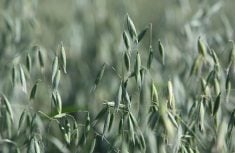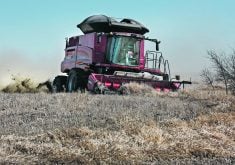Canola candidate for no-till
If you grew canola this year, there’s a good chance you can save time and money next year by seeding directly into fields without tillage.
“Canola produces less crop residue than wheat and breaks up faster than cereal straw. Also, canola is seeded at a lower plant population, making it easier to seed right into canola stubble in the spring,” says Peter Entz, a Manitoba Agriculture land management specialist.
Reducing tillage is also a good way to conserve seedbed moisture for next spring. Canola usually uses about the same amount of water as cereal crops, but in a dry year can use more water than wheat or peas at the 51- 91 centimetre (20-36 inch) depth.
Read Also

VIDEO: Ag in Motion documentary launches second season
The second season of the the Western Producer’s documentary series about Ag in Motion launched Oct. 8.
“Excess tillage will dry out the seedbed, and if you’re already low on moisture, the problem becomes worse.”
Canola residue must be well-distributed, particularly the chaff. “A poorly distributed canola swath can result in dense rows of volunteer canola for the next year,” says Kendall Heise, soil conservation specialist at Shoal Lake. Heise also cautions farmers not to cut canola too high. A stubble height of 30.5-38 cm (12-15 inches) is the limit for high clearance seeding equipment.
Also consider weeds that will pose problems if you eliminate tillage, said David Kelner, a Manitoba Agriculture weed specialist. “Weeds such as stinkweed and shepherd’s purse could be a problem in the next year’s crop,” Kelner said. “Preharvest Roundup is usually applied before winter annuals germinate. A shot of 2,4-D just prior to freeze-up will be necessary.”
– Manitoba Agriculture
Controlling wolf plants
Lightly or unevenly grazed crested wheatgrass pastures will develop stag or wolf plants – plants that have set seed and are not grazed.
This leads to large, stemmy plants with considerable dead material. Even the green growth isn’t available to livestock because of interference from the old reproductive parts.
“Wolf plants represent a significant loss of forage,” says Michel Tremblay, forage specialist with Saskatchewan Agriculture. But it’s difficult to assess this loss of forage.
A government and university project aims to correlate economic losses with wolf plant densities to measure that loss.
Objectives of the project are: to find out how much usable forage is lost by various densities of wolf plants; to determine the costs of management and renovation techniques; and to find the point at which wolf-plant density is great enough to warrant management changes or renovation .
Study sites were established in the brown, dark-brown and black soil zones of Saskatchewan in 1994. Data will be compiled, analyzed and interpreted over the next two years and released in 1996.
The project is supported with money from the federal Green Plan.
– Saskatchewan Agriculture














